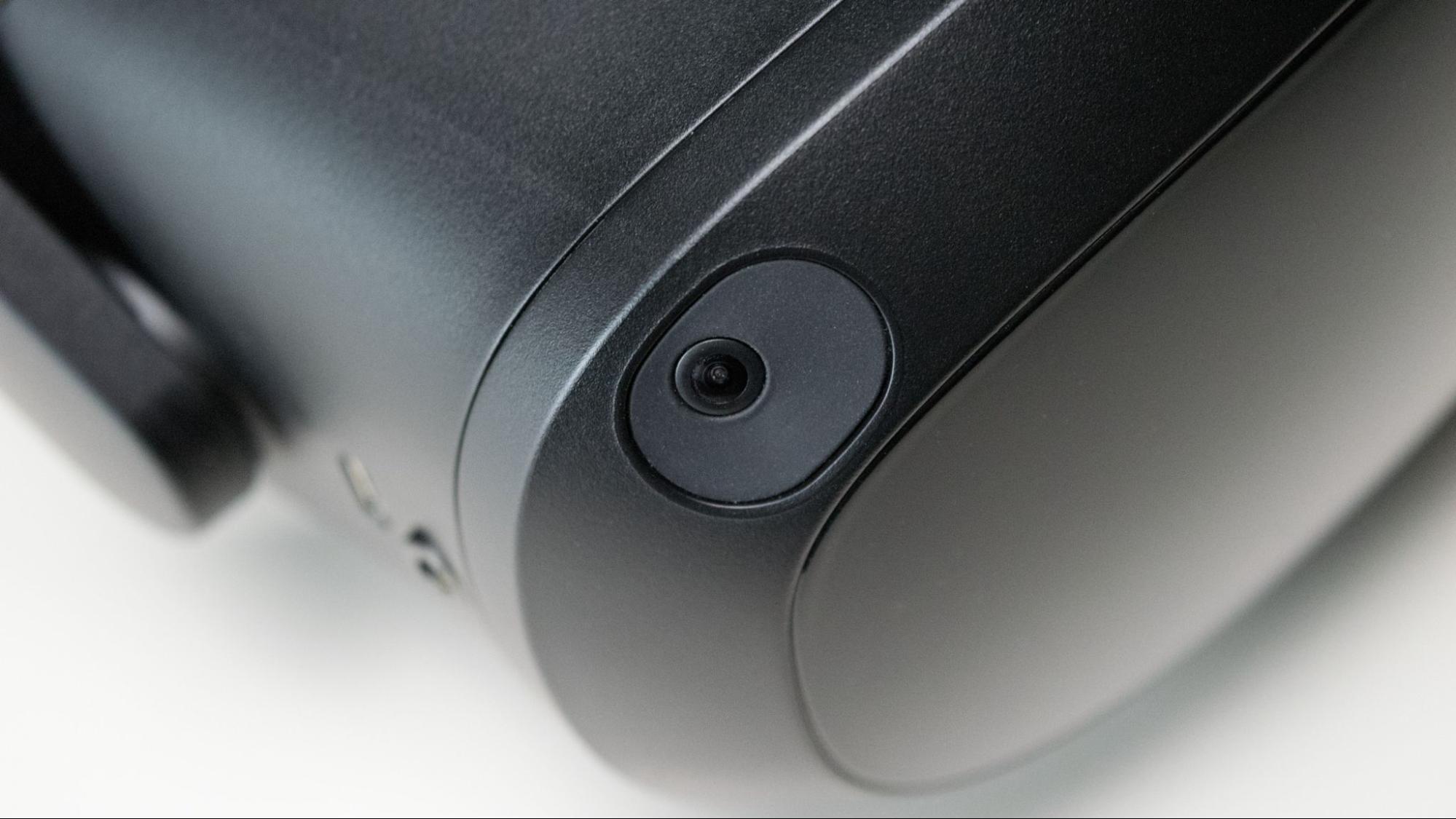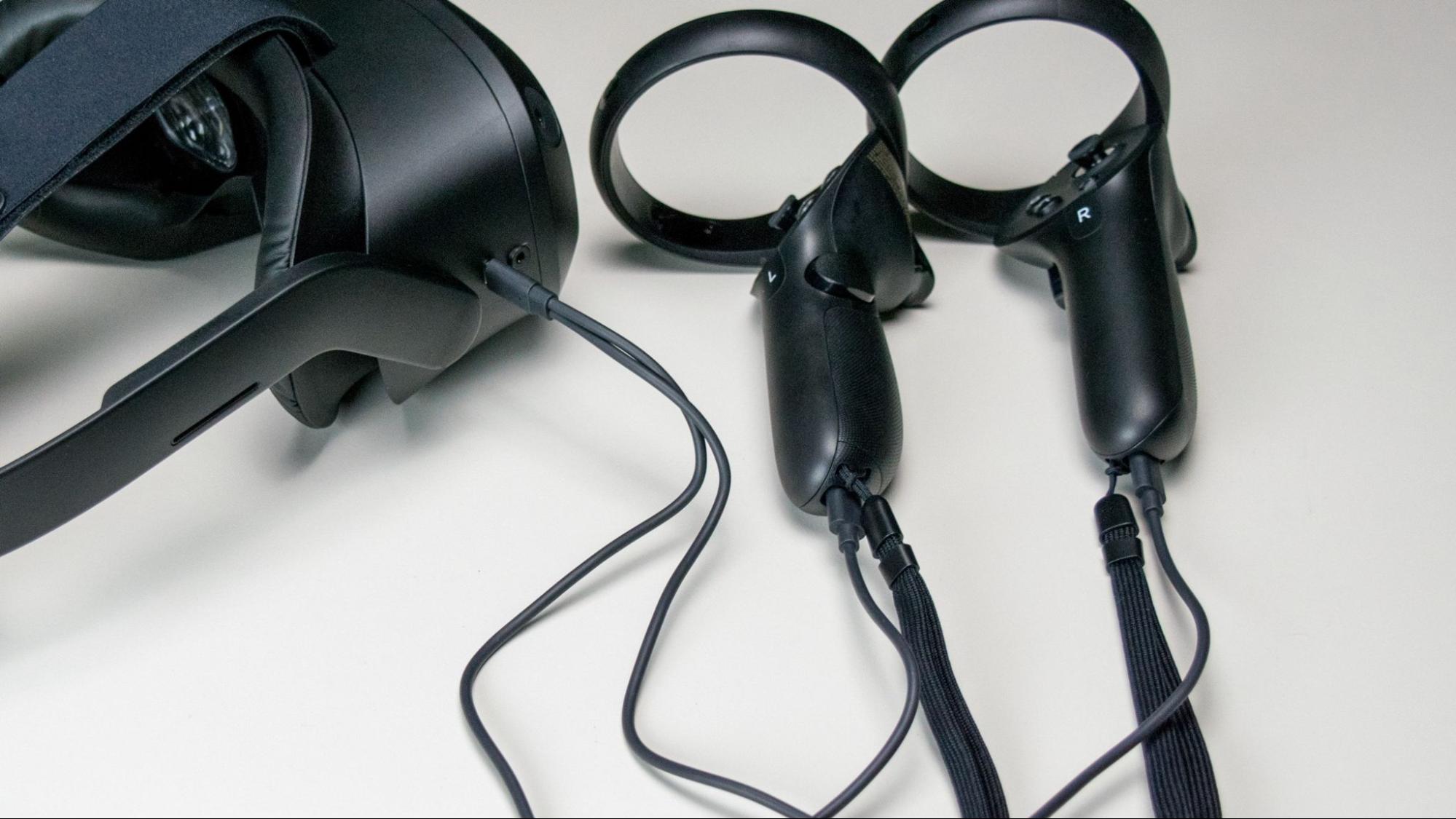Tom's Hardware Verdict
The HTC Vive Focus 3 is the best standalone headset that we've tested. The screens are great, the performance is excellent, the field of view exceeds the competition by a significant margin, and the tracking is phenomenal. This headset has almost everything we'd like to see in a high-end consumer device. It's a shame this isn't for consumers.
Pros
- +
+ Widest FOV in a standalone headset
- +
+ Excellent display resolution
- +
+ Well-balanced weight
- +
+ Moisture-proof materials
- +
+ Micro SD card slot
- +
+ Replaceable battery
Cons
- -
Expensive
- -
Mediocre controller ergonomics
Why you can trust Tom's Hardware
On paper, the HTC Vive Focus 3 is easily the best VR headset in the standalone form factor (no connection to a system required) that has ever been released. It is precisely what we'd expect from a high-end VR system for gamers with deep pockets and a desire for the best of the best.
The Focus 3 ($1,300 as of writing) is the most well-equipped standalone headset that we have ever tested except for one thing: it doesn't have a consumer-facing software marketplace, making it effectively useless for gamers and only viable for businesses or developers. HTC was clear from day one that the Focus 3 would be a business device, but it would have been nice to see a high-end competitor shake Facebook's grasp on the standalone market.
HTC Vive Focus 3 Specs
| SoC | Qualcomm Snapdragon XR2 (Snapdragon 865) |
| Storage | 128GB internal, up to 2TB micro SD card |
| RAM | 8GB |
| Per-eye Resolution | 2448 x 2448 |
| Display Technology | 2x 2.88-inch (73.15-mm) LCD panels |
| Lens Technology | Dual-element |
| Refresh Rate | 90 Hz |
| Field of View (FOV) | 120 degrees |
| Interpupillary Distance (IPD) | 2.24 - 2.83 inches (57-72mm) |
| Sensors | Hall sensors, capacitive sensors, G-sensor, gyroscope |
| Tracking Technology | HTC Vive inside-out tracking |
| Cables | Y-cable for controllers, charging cable |
| Connectivity | 2x USB 3.2 Gen-1 Type-C peripheral ports, external USB-C port supporting USB OTG, Bluetooth 5.2, Bluetooth Low Energy, Wi-Fi 6 |
| Audio | 2x microphones with echo cancellation, 2x directional drivers2x microphones with echo cancellation, 2x directional drivers |
| Weight | 1.73 pounds (785g) with battery |
Meet the HTC Vive Focus 3
The Vive Focus 3 is HTC's third standalone VR headset, but it is the first one to get an official Western release. Sadly, HTC targets businesses with the Focus 3, which is not meant for a consumer audience, which is a shame because it is a capable device that gamers would appreciate, if not for the hefty $1,300 price tag.
The Focus 3 is an Android-based device powered by a Qualcomm processing unit. HTC equipped the device with a Snapdragon XR2 SoC, the same processing unit found in Facebook's Oculus Quest 2. HTC has not released detailed configuration specifications with the clock speed of the CPU and GPU. However, a representative told us it added a fan for active cooling to achieve higher sustained performance from the processing unit. Unfortunately, we have no way to verify that claim independently.
The headset includes 8GB of RAM and features 128GB of internal storage. A previous version of this review noted that we could not find an SD card slot, even though the storage management app indicated there was an 8GB Sandisk SD card installed. HTC has since pointed out that the slot is located under the face cushion near the left side of the headset. It is an unmarked slot, and with a Micro SD card already installed, it blended in and we missed it. The card was hidden in plain sight.
Our review sample came with an 8GB card pre-installed, which contained a 360-degree video sample or The Sick Rose poem. The card slot can read Micro SD cards up to 2TB in capacity, making it easier to load movies and custom applications on the headset. From a developer standpoint, the card slot would be very helpful for deploying private software without an internet connection. From a consumer standpoint, the card slot would allow you to easily view home videos captured with a 360 camera.
The Focus 3 features the same 2448 x 2448 per eye RGB displays as found in the Vive Pro 2, although the standalone device's refresh rate is limited to 9 0Hz. The headset also features HTC's newly developed dual-element lenses, which give you a wide, 120-degrees field of view. On the bottom, there's an analog IPD adjustment dial, which provides you with a range of 57 to 72mm.
Get Tom's Hardware's best news and in-depth reviews, straight to your inbox.
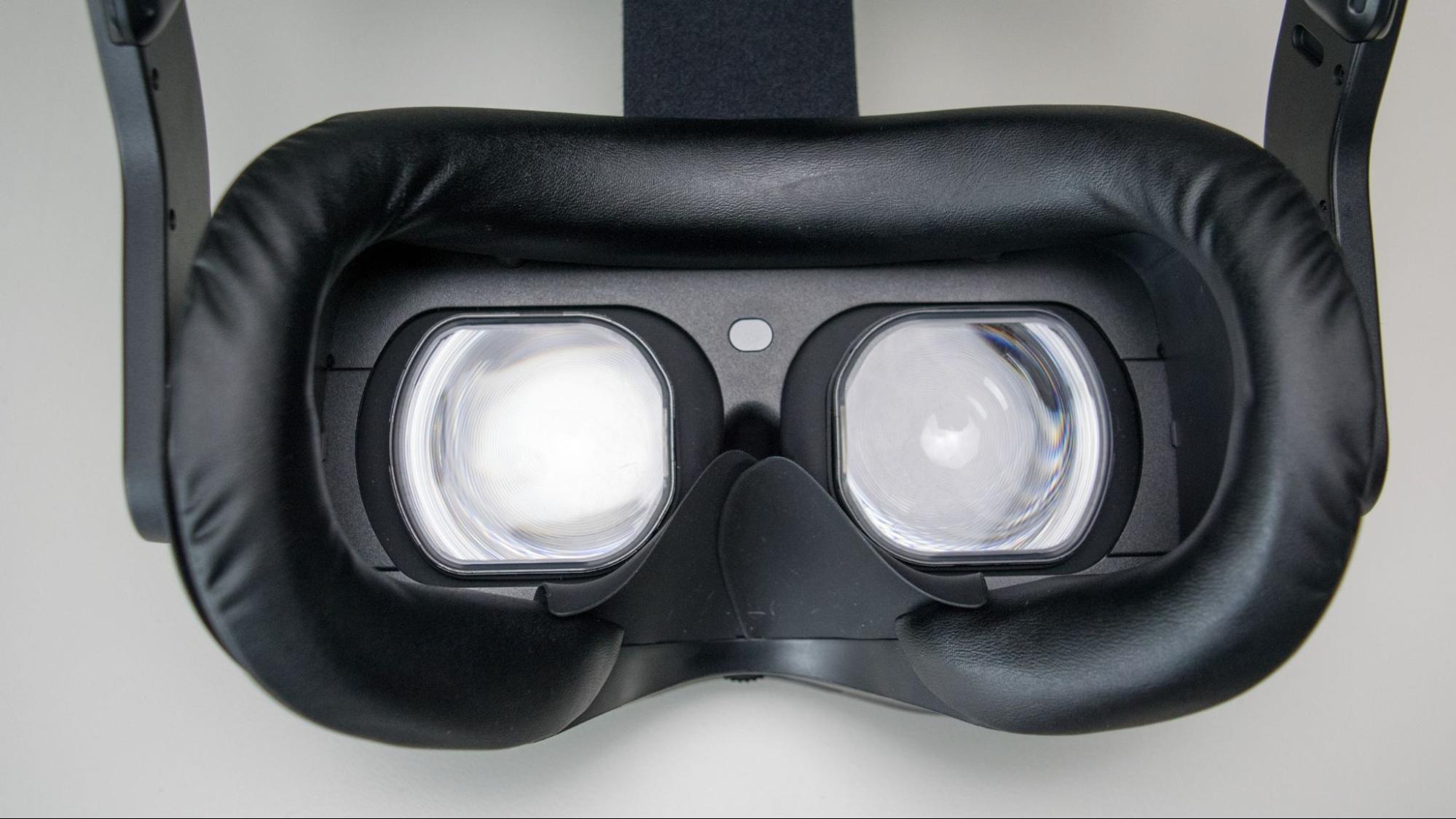
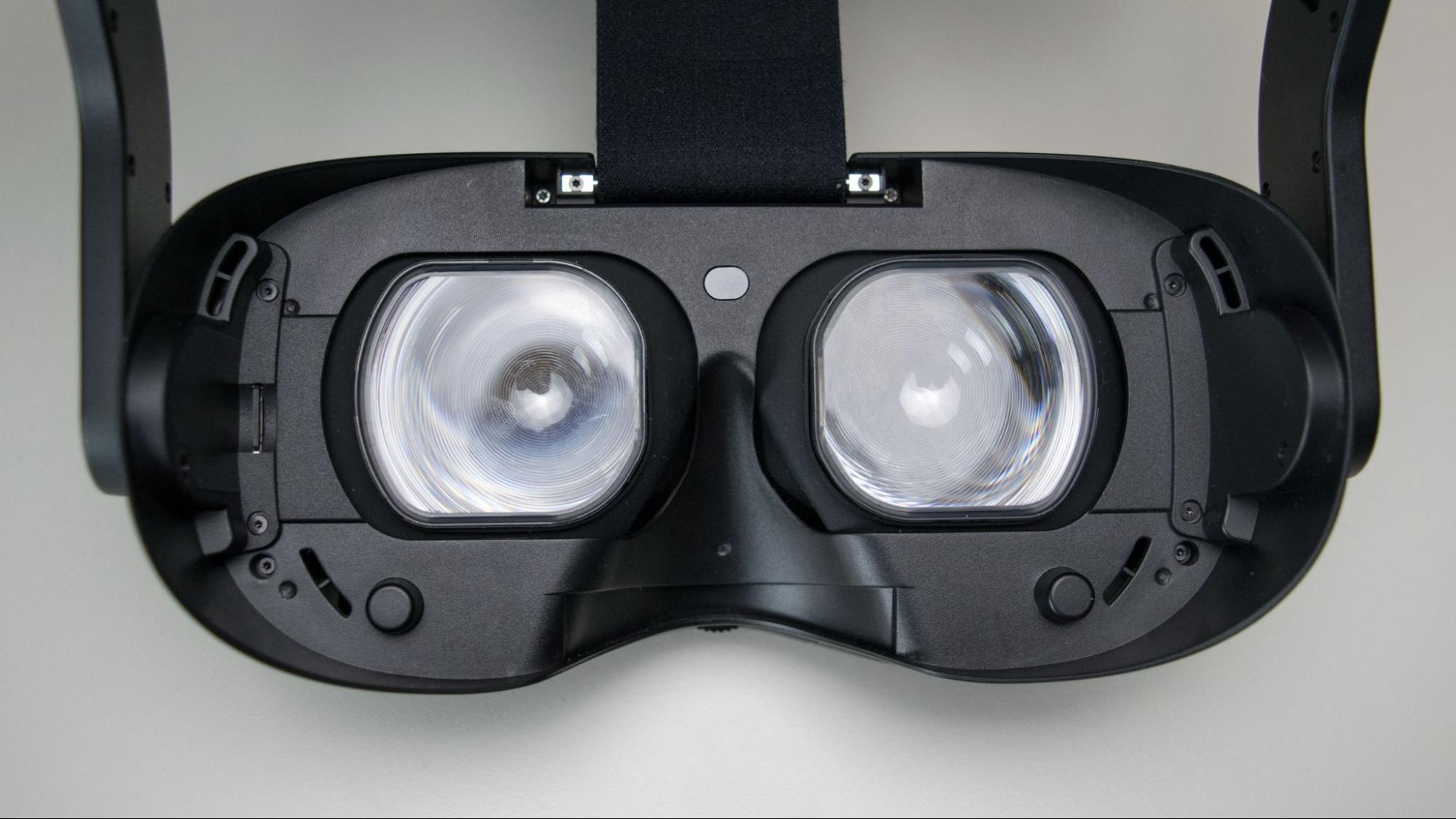
Compared to the Quest 2's tunnel vision effect, the viewport in the Focus 3 feels expansive. Unfortunately, these lenses produce very noticeable godray refractions, which negatively impact image clarity. The lenses in the Quest 2 have less refraction, but the screens in the Focus 3 are much crisper. It's hard to say which is better.
Aside from the new lenses and high-resolution displays, HTC crammed many innovations into the Focus 3. For example, the headset features a brand new head strap design that changes how the headset sits on your head. Unlike previous Vive headsets, which cupped the lower part of the back of your skull, the Vive Focus 3 sits more like a baseball cap on top of your head. The strap angles up from the visor and the rigid structure extends above your ears to the back of your head.
The rear of the strap features a mechanical dial to tighten the fit. Below the dial, you'll find a button that releases the tension when you want to remove the headset or resize it for someone else. The sides of the head strap feature integrated down-firing speakers. The internal speakers give plenty of volume for most use cases, but you can also plug in headphones if you desire a better audio experience.
The front of the headset features a glossy section with the Vive logo. The rest of the visor is constructed of lightweight magnesium alloy. The material helps keep the weight to a minimum while also facilitating cooling for the internal components. In addition, HTC installed a heatsink inside the visor, which you can see through vent holes on the top and bottom of the headset, which is actively cooled by a small fan. When the headset is running, you can hear the fan spinning.
The fan also pushes a slight breeze into the visor, which can dry out your eyes after long periods of use.
The Vive Focus 3 features four visor-mounted cameras which handle spatial awareness and controller tracking. HTC used the same camera position configuration, and Facebook did with the Quest 2. The headset includes cameras on the upper front corners, which face slightly upwards and partially forwards. The two lower cameras are not as close to the corners and face somewhat towards the ground. Combined, these four cameras give you ample controller tracking range with next to no blind spots except behind you. The tracking accuracy is at least on par with the Quest 2.
On the left side of the headset, you'll find the menu button. On the opposite side, there's a headphone jack and a USB Type-C port. The headset does not charge through the USB port, but it can power up the controllers through the Type-C port. The headset must be on to pass power through to the controllers, and HTC includes a Y-cable to power both controllers at once.
On the bottom side of the headset, you'll find the volume rocker button and the IPD adjustment dial. A small magnetic panel in front of the IPD dial covers an additional USB-C port.
The Focus 3 is the first headset that we've tested that does not need any hygienic upgrades. The face cushion features a soft memory foam wrapped with a moisture-resistant PU leather covering. The face cushion is also mounted to a magnetic bracket that allows you to remove it for cleaning or swap it for a fresh one. The rear cushion is also moisture resistant, removable, and washable, although it's not as soft as the face cushion.
Removing the rear cushion exposes the battery pack for the headset, which is also removable. The battery can be charged while inside the headset, but you can also charge the batteries outside the device. The battery pack has a barrel connector, which accepts the 12v power adaptor that HTC has used to power all its past headsets.
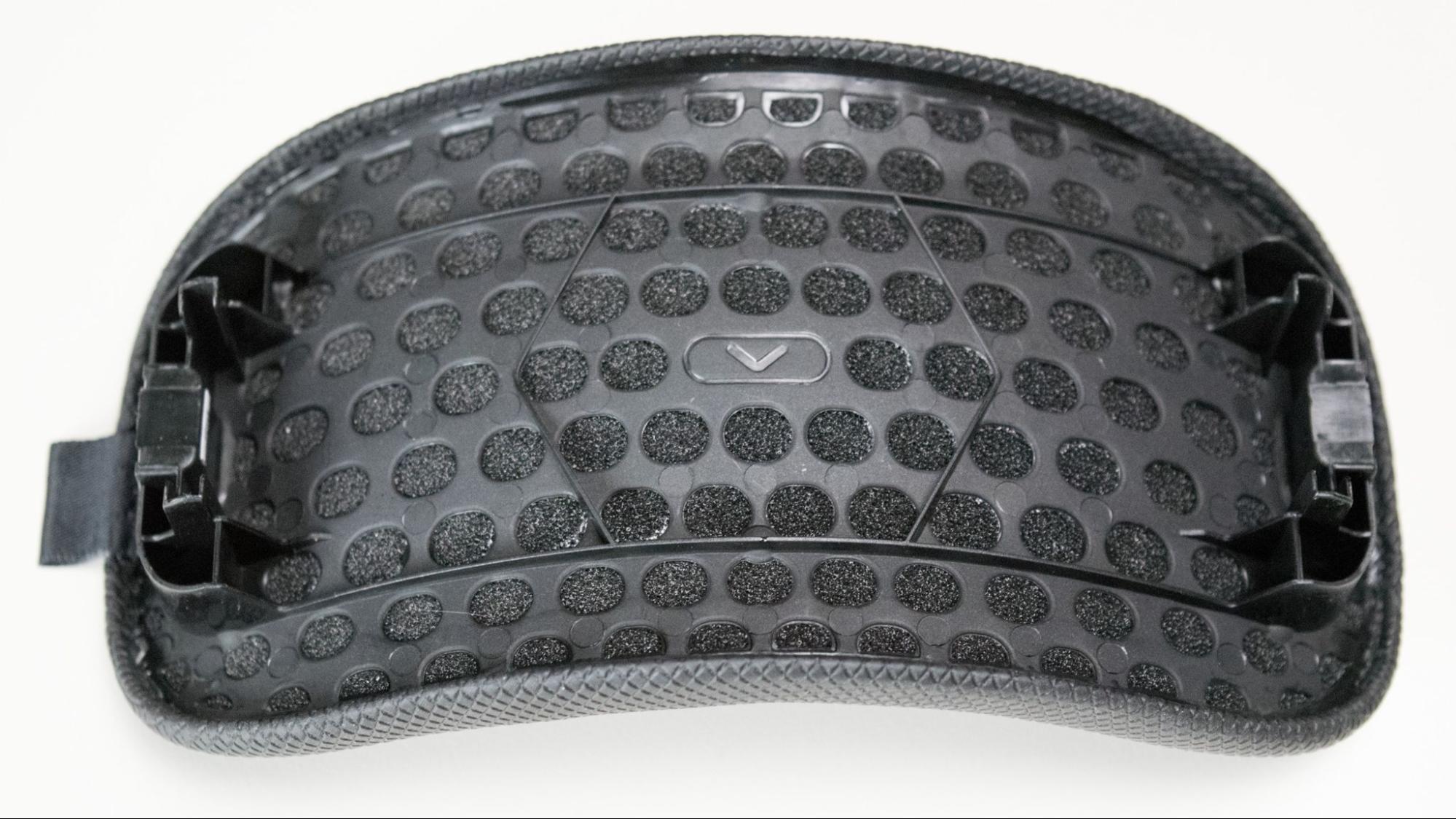
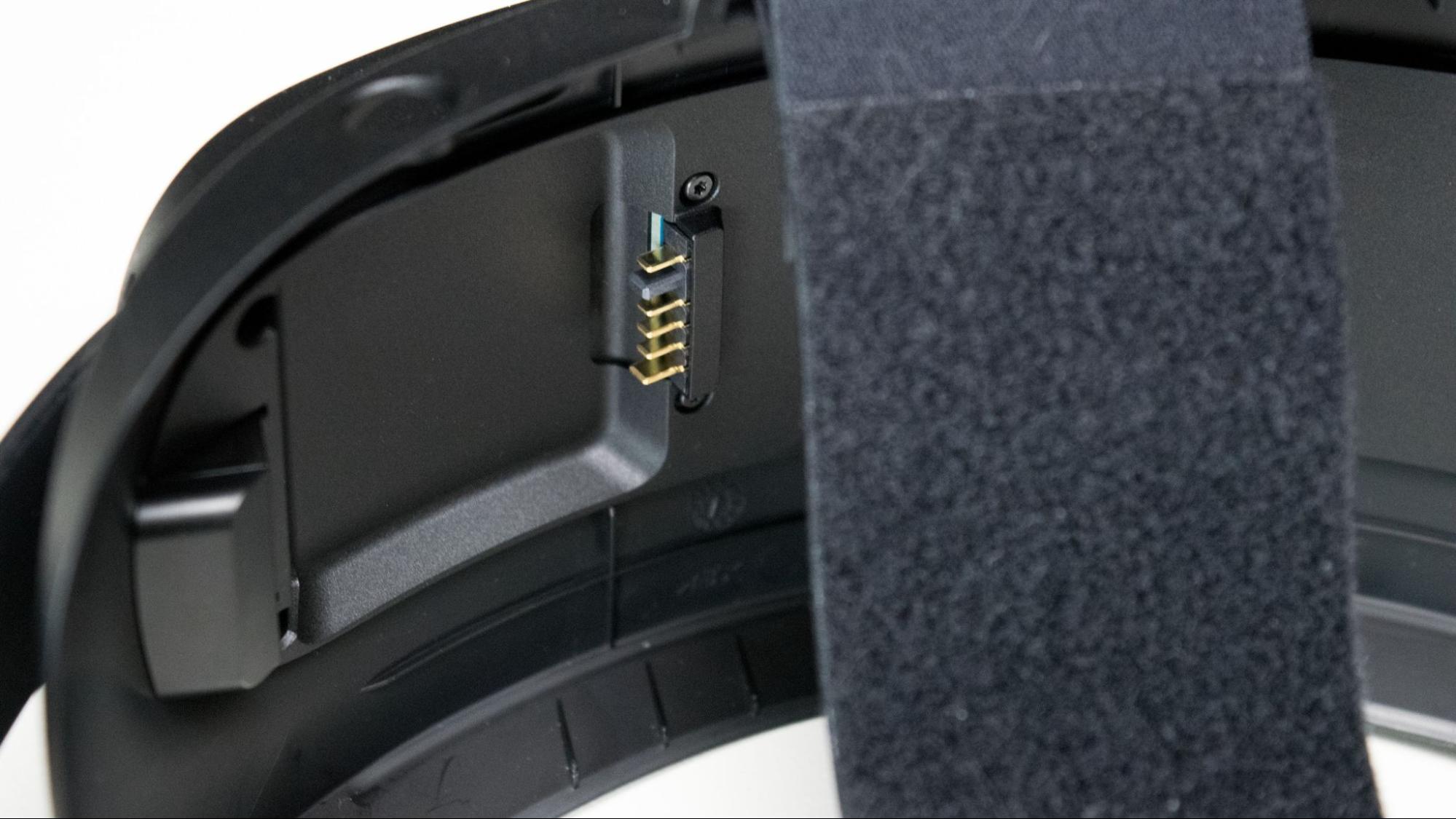
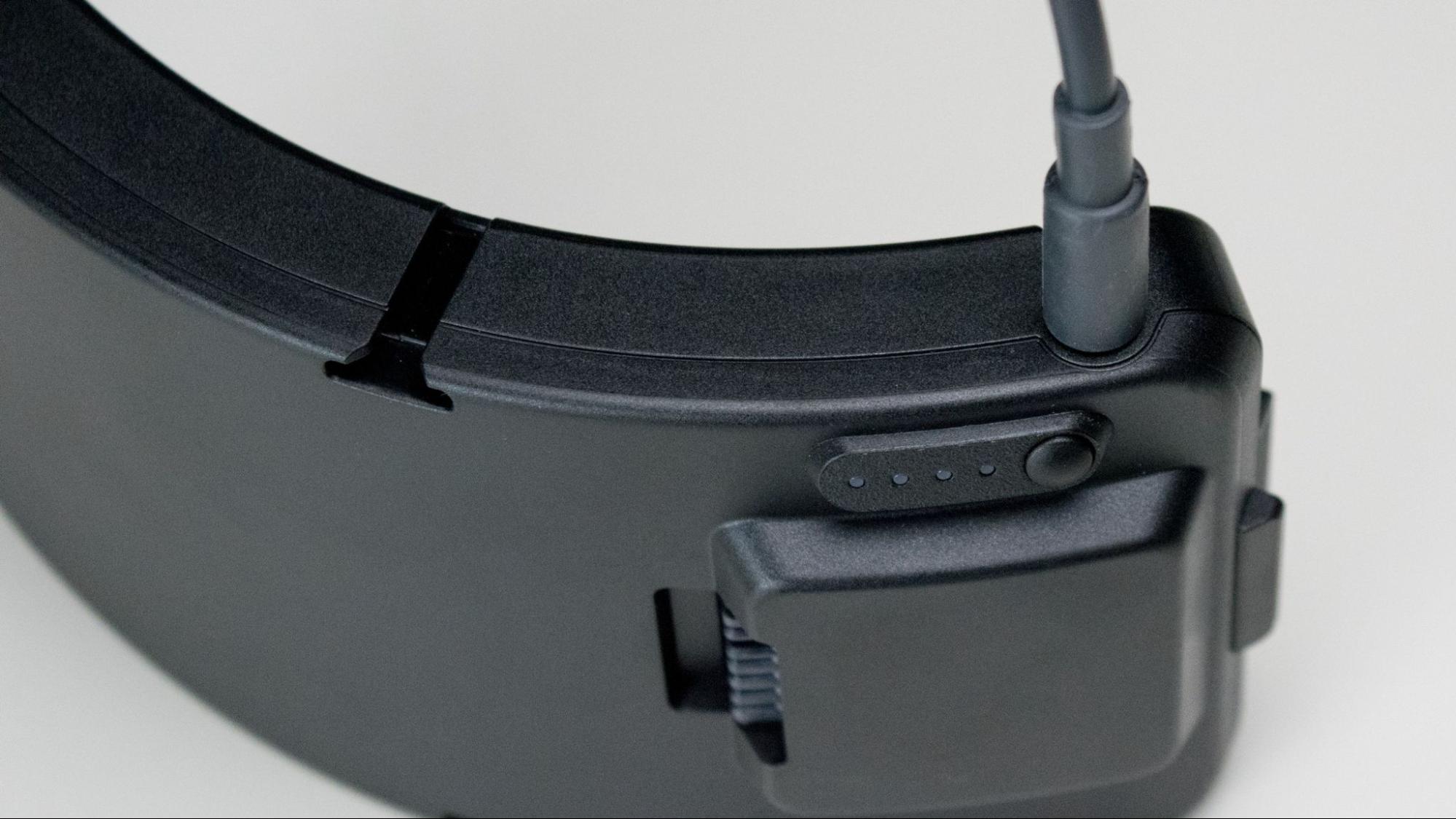

With the battery pack on the rear of the headset, so too is the power button. The button is actually on the battery pack, and it doubles as a power button and a charge check button. If you press it for one second, four LEDs will light up, indicating the level of charge the battery holds. Likewise, pressing the button for three continuous seconds will power the device on or off.
Mediocre Controllers
It feels like much thought was put into the design of the Focus 3 headset, but the controllers don't give the same impression. While they aren't the worst motion controllers we've ever used, HTC still hasn't learned its lesson regarding peripheral ergonomics. For example, the shape of the handles is not well optimized for the form of the human hand. The extended length of the handles is excellent, but they do not contour your hands well.
On the bright side, the Focus 3 controllers have input parity with the Quest controllers. They include A, B and X, Y buttons, a thumbstick on each side, and a Vive home and menu button. Each controller also gives you a trigger and grip button.
The Focus 3 controllers feature internal lithium-ion batteries with a USB Type-C charge port on the bottom of each handle. Like the Quest controllers, the Focus 3 controller features a halo with infrared LEDs for tracking.
Using the Focus 3
The headset that HTC provided us for this evaluation is a pre-release model which does not have all of its features enabled. However, the headset came pre-loaded with a small selection of apps for reviewers, which we'll get into in the dedicated section below.
When I first started the headset, we were greeted with a message telling us to download the companion app for my smartphone or the desktop software for my computer. Unfortunately, those apps were not available ahead of launch, so we have not tested them out.
To bypass the app install screen, press and hold the menu button on the left side of the headset. A progress bar will fill up as you hold the button, and when it completes, the app message goes away, and you'll find yourself in passthrough mode with an initial configuration process to follow.

First, you set the language. Next, it explains how to find the sweet spot for the lenses with a calibration image to help you line it up exactly right. You start with the vertical alignment, where it teaches you to move the headset up and down until the horizontal lines look perfect. Finally, tighten the overhead strap to hold it in place.
The next step is the IPD adjustment, which is done with a dial found below your nose on the bottom of the visor. The on-screen calibration gives you a readout with two decimal points, but the dial isn't that precise, and we found that the measurement update interval doesn't keep up with the dial movement.
The next step is to connect the controllers. The process is simple and involves pressing the Vive logo button on the right controller and the hamburger button on the left controller. The pairing process took less than a second.
Calibrating the tracking guardian works exactly how it does with the Quest 2. First, confirm the ground height. If the headset is not detecting the correct height, reach to the floor with one of the controllers to set the floor position. Next, trace the border of your safe place space by pointing the controller at the ground while pulling the trigger. Once you've set the guardian, the passthrough view fades away to the virtual environment.
Home Environment
The Vive Focus 3 home looks like a modern office space that overlooks a desert scene. The environment is fancy, but the menu system is relatively basic. We could log in to our Viveport account; However, it did not give us access to the Viveport marketplace. You can access the content library, which provides you with a tiled listing of the installed software. You also get a settings menu to adjust some of the configuration options for the headset.
In the settings general menu, you can set the time, date, see the headset software version and prompt it to check for updates, and enable double-click passthrough view. In the boundary section, you can change the color and opacity of the boundary, enable automatic passthrough when you step through the boundary, and recalibrate the floor and safe area.
The connectivity tab allows you to enable Bluetooth and monitor the controller pairing. The network section gives you the Wifi configuration settings and the ability to configure a VPN connection. The Kiosk Mode section allows you to configure the headset to launch directly to one or more apps without giving users access to the menu and entire content library.
The storage section allows you to see the available free space and uninstall apps. It does not give you access to a file manager to open locally saved files or run private APK installers. The advanced section gives you access to USB debugging, enables installs from unknown sources, sets the sleep mode timer, and adjusts the camera polling setting. The factory reset button is also under Advanced.
The Vive Focus 3 is a Snapdragon XR2-based headset, the same processing hardware found in Facebook's Oculus Quest 2. Therefore, games built for Quest should theoretically be compatible with Focus 3 with minor changes from the developer. Furthermore, Qualcomm developed a wireless streaming feature for the XR2 platform, so Focus 3 should be capable of streaming PC VR games wirelessly to the headset.
At present, neither of those two options is possible. However, we did locate an option in the system settings that suggests a future software update could enable SteamVR streaming in the future. If that happens, the Vive Focus 3 could develop a niche following of enthusiast gamers. However, most of these headsets will be used for business training, remote collaboration, product design or in location-based entertainment facilities.
The Focus 3 Is Fast
One of the most prominent things that stood out about the Focus 3 is how fast it is. From a cold boot, the headset takes just a few seconds to get you right to the home environment. The screens turn on immediately and the Vive logo spins in front of you while it boots, giving you something visually interesting to look at while you wait. At no point did it feel like we were waiting around too for something to happen.
Likewise, loading content from the home environment is rapid and always engaging. There's nothing worse in a VR headset than sitting at a blank screen while something loads in the background, and we never experience that problem in the Focus 3. Jumping from one app to the next is quick and getting back to the home screen is an almost immediate process.
HTC Vive Focus 3 Apps
As mentioned, we tried out the apps pre-loaded for reviews on the Vive Focus 3 to get an idea of the experiences business users can expect. HTC told us that the Vive Focus 3 would be compatible with SteamVR content with use of something called the Vive Business Steaming cable. The company didn't provide additional details about the cable, but we imagine it would be similar to Facebook's optical USB Link cable for the Quest 2. A wireless streaming app is also in development, and HTC said it would be available soon.
Hyper Dash was the only game. It's a team-based multiplayer shooter that's also available on consumer headsets. HTC said it included the game as an example of what you may see at a VR arcade. The game plays very well on HTC’s hardware, with no hint of performance issues while driving the high-resolution screens. This game also demonstrated the tracking quality, with no trouble keeping the weapon aimed where we wanted it to point.
Playing Hyper Dash on the Focus 3 was an excellent experience. We didn't notice an appreciable difference between playing on the Focus 3 versus playing on the Quest 2, but the broader field of view makes keeping an eye on your enemies a bit easier in HTC's headset.
The headset also included Firefox Reality, the VR version of the Firefox web browser. Firefox Reality allows you to browse to any website, as you would with any device. Unlike most headsets, the Focus 3 has a high enough resolution actually to read text on websites.
Firefox Reality also natively supports WebXR experiences, so you can seamlessly jump in to full 6DoF VR directly from a browser window. As immersive technologies are integrated further into our web experience, having a device like the Focus 3 will allow you to consume future web content easily.
Bodyswaps by JCR Group is an immersive learning experience that teaches people to reflect on their behavior in work situations and to help promote a more empathetic approach to interacting with others. The virtual situations are created by behavioral scientists. The Bodyswaps demo offers one experience and puts you through a roleplay scenario from the perspective of multiple parties to help you feel more empathetic towards others. The graphics in the app are cartoonish yet serious, with well-modelled avatars that depict realistic facial expressions. The simulation is well put together and does an excellent job of convincing you that you’re in the meeting with two other people. We can see this being a valuable tool for business training.
Mona Lisa: Beyond the Glass is a VR tour of part of the Louvre in France. The courtyard is fully rendered in near-photorealistic detail, and you can explore all around it via teleport. You can move right up to the paintings hanging in the Grand Gallery, and with the clarity of the Vive Focus 3’s screens, you can see enough detail to appreciate these masterpieces. For each painting, there is an accompanying narrative clip explaining the significance.
All these apps are available via the Vive Business AppStore.
Final Thoughts
Spending more than a week with the Focus 3 made one thing abundantly clear: Facebook's effect on the VR market is a double-edged sword. On the one hand, the consumer VR market needs affordable hardware to drive adoption. But, on the other hand, selling hardware at far below profitable margins has set an unrealistic expectation of price in the eyes of consumers, forcing would-be competitors to think twice about challenging Facebook.
Facebook priced the business version of its Oculus Quest 2 at $799, severely undercutting the competition. HTC built what is undeniably a better piece of hardware. However, it cannot sell the product at a price the consumer market would bear. The Focus 3 is a much better device than the Quest 2 for many reasons, but few people would see $1,000 worth of value in those differences. HTC is not alone. Very few companies could ever fathom competing at this level and hope to come out ahead on the other side, which is why no one else is competing in this space, even though Qualcomm did all the heavy lifting with its XR2 reference design.
HTC put together an excellent package with the Vive Focus 3. Businesses that adopt this platform will undoubtedly love the features and the performance. It's a shame that gamers won't see the benefits of a healthy competitor in the standalone consumer VR space just yet.
Editor's Note June 28, 2021: This review was originally published on June 24, 2021 and was updated on June 28, 2021 to include information on the Micro SD card slot.
Kevin Carbotte is a contributing writer for Tom's Hardware who primarily covers VR and AR hardware. He has been writing for us for more than four years.
-
-Fran- Facebook is heavily subsidizing the Quest 2 in order to get more audience to target advertisement to. There's all there is to it.Reply
I have the Valve Index and it's just unbeatable in quality with the current round of headsets. From what I've read in this article, this is a worthy competitor, but the Index 2 is already under development, as I understand it (I could be totally wrong). Plus it has trackers. It's just overall better, albeit more expensive. And no Facebook ads!
Regards, -
warezme I have the HP Reverb G2 and other than the FOV is the best VR headset I've owned. I had the original HTC Vive and even had the Valve Index for a short time but due to loud whining bases more screendoor than I cared for I returned it. The G2 has the best clarity and sharpness I have experienced yet. I even did the faceplate mod to increase the FOV but it's till not as good as I would have liked. If HP came out with a G2 version with a wide FOV it would be killer.Reply -
kcarbotte ReplyYuka said:Facebook is heavily subsidizing the Quest 2 in order to get more audience to target advertisement to. There's all there is to it.
I have the Valve Index and it's just unbeatable in quality with the current round of headsets. From what I've read in this article, this is a worthy competitor, but the Index 2 is already under development, as I understand it (I could be totally wrong). Plus it has trackers. It's just overall better, albeit more expensive. And no Facebook ads!
Regards,
The Index is still the best overall package for most gamers. There are headsets with better screens, and headsets with wider field of view, but no headset is better overall yet.
Reverb G2 has great screens, great audio, and poor FoV. Pimax 8K X has amazing FoV, good screens, decent audio. Vive Pro 2 has great screens, not so great lenses, good FoV and decent audio. Index has excellent audio, good FoV, good screens, good lenses.
For most gamers, a wired headset is still going to be the best solution, but a Quest 2 over Air Link is a pretty great experience.
As of this morning, software exist that will allow you to play SteamVR content on the Focus 3, which may give people another reason to consider the Focus 3 for home use. -
-Fran- Reply
That's the thing... Other than the Pimax 8K, I've tested all the others, but the most comfortable, better overall experience was the Index by far for me. Specially since I wear glasses and they are not instrusive in the Index at all. The others had one quirk or another with my glasses which was a big turn off. And, while totally subjective, the speakers on the Index are just better. Plus the mic is really good. And the forward facing cameras are really helpful at times when you don't want to take off the headset.kcarbotte said:The Index is still the best overall package for most gamers. There are headsets with better screens, and headsets with wider field of view, but no headset is better overall yet.
Reverb G2 has great screens, great audio, and poor FoV. Pimax 8K X has amazing FoV, good screens, decent audio. Vive Pro 2 has great screens, not so great lenses, good FoV and decent audio. Index has excellent audio, good FoV, good screens, good lenses.
For most gamers, a wired headset is still going to be the best solution, but a Quest 2 over Air Link is a pretty great experience.
As of this morning, software exist that will allow you to play SteamVR content on the Focus 3, which may give people another reason to consider the Focus 3 for home use.
And, as I said before, HTC and Valve use the same tracker technology, so that's a HUGE plus for them. The trackers make the whole experience a bazillion miles better than anything else in the market.
Regards. -
comedichistorian Reply
The Reverb really felt like an upgrade after the Index? Ive been wanting to make that leap but I’ve been hesitant cause I’m cheap and lazy lol. But yeah, the Index physically felt like an upgrade - easier to take on and off, built in headset etc but, coming from modded fresnel-less Vive, I only saw a mild upgrade in image quality and that was disappointing. I also don’t play a lot of games that require VR controllers on my PC-tethered headset. Those I play on the Quest 2.warezme said:I have the HP Reverb G2 and other than the FOV is the best VR headset I've owned. I had the original HTC Vive and even had the Valve Index for a short time but due to loud whining bases more screendoor than I cared for I returned it. The G2 has the best clarity and sharpness I have experienced yet. I even did the faceplate mod to increase the FOV but it's till not as good as I would have liked. If HP came out with a G2 version with a wide FOV it would be killer.
Anyway lol, so you definitely noticed a sizable difference in sharpness going from an Index to a reverb huh? -
D-money813 Reply
Vive Pro 2 is the new consumer kingYuka said:Facebook is heavily subsidizing the Quest 2 in order to get more audience to target advertisement to. There's all there is to it.
I have the Valve Index and it's just unbeatable in quality with the current round of headsets. From what I've read in this article, this is a worthy competitor, but the Index 2 is already under development, as I understand it (I could be totally wrong). Plus it has trackers. It's just overall better, albeit more expensive. And no Facebook ads!
Regards, -
D-money813 Replykcarbotte said:The Index is still the best overall package for most gamers. There are headsets with better screens, and headsets with wider field of view, but no headset is better overall yet.
Reverb G2 has great screens, great audio, and poor FoV. Pimax 8K X has amazing FoV, good screens, decent audio. Vive Pro 2 has great screens, not so great lenses, good FoV and decent audio. Index has excellent audio, good FoV, good screens, good lenses.
For most gamers, a wired headset is still going to be the best solution, but a Quest 2 over Air Link is a pretty great experience.
As of this morning, software exist that will allow you to play SteamVR content on the Focus 3, which may give people another reason to consider the Focus 3 for home use.
how can you crown the index's lenses and then say vp2 doesnt have great lenses?? those two headsets are the gods of godrays! Index has been beaten but its 1 hmd release vs 4 so valve will retake #1 spot whenever they decide to drop something but the index is still selling well





